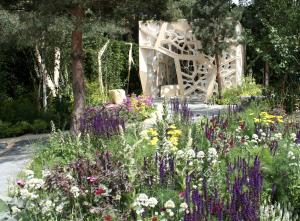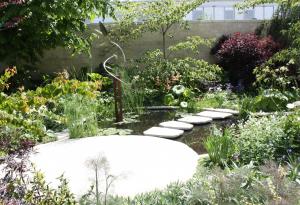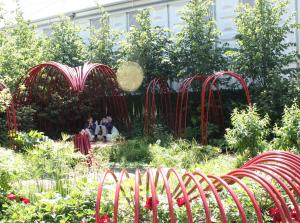RHS Chelsea Flower Show 2011
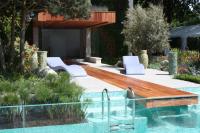
On Monday 23 May we visited the annual RHS Chelsea Flower Show in the heart of London's West End for Press Day.
This was my first visit to what many people consider to be the worldís finest flower show. To begin with I was overawed. As soon as you walk in to the show on Press Day you are mingling with celebrities. I spent a lot of my time at the show interviewing them for our podcast, but when not talking to the stars, I found time to enjoy the show.
Being new to Chelsea I was struck by how the designers had packed the plants into their exhibits. Despite only being a few days old, the finished show gardens are remarkable in their mature and polished appearance. The Chelsea Flower Show is just that, it is pure horticultural theatre. Some of what you see is outrageously over the top and just not possible on the average budget, but what you get and take away from Chelsea is a selection of thought provoking ideas, one or two from each garden or exhibit that you can maybe mimic in your own garden.
Throughout the show, I was particularly impressed by the designerís skill in using the non-flowering features of the plants to paint a wonderful picture. Some of the best show gardens were almost completely devoid of any plant colour other than green. Yet the use of various shades of this most relaxing, aesthetically pleasing colour in association with plant structure, foliage texture and non-living design and construction was incredibly clever and striking.
These were my 3 favourite show gardens:
The Times Kew Garden
A slightly biased opinion, being a former Kew Gardener, I really liked this garden, although it only managed to achieve a silver medal from the judges. I always admire people who are brave enough to completely change their career and itís direction. This garden was designed by a former Scots Guardsman, Marcus Barnett.
The aim of the design was to emphasise the importance of plants in our everyday lives. In some way, all of the plants in this garden have a use which is either medicinal or commercially beneficial; having a positive beneficial impact on economies throughout the world and contributing to the health and well-being of mankind.
Some of plants used included:
Angelica
An essential oil is extracted from the seeds and roots of Angelica, it is used to flavour some spirits and liqueurs. The oil is also used in perfumes.
Betula utilis
The bark of this tree is used to make packaging materials. It is also used to treat Hysteria. The wood is used in the construction of bridges in some parts of the world.
Campanula
Some of the plants in this Genus are sources of oil and rubber.
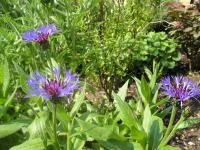 Centaurea montana
Centaurea montana
When infused, the Mountain cornflower has been used to treat constipation and coughs. It is also used to treat bleeding gums and eye infections.
Digitalis purpurea
In terms of itís use the foxglove is probably the star of this garden. It is used in the medical profession to treat congestive heart failure. As a constituent of some cardiac drugs, it has helped to make hearts beat more regularly and slowly.
The Trailfinder's Australian Garden
I liked this garden because it has a historic theme. Many show gardens at Chelsea focus on the future, the very latest designs and brand new plant cultivars. This garden was modern and very attractive in its appearance but it was also a celebration of the work of one of our greatest plant hunters; Sir Joseph Banks. The dedication and persistence of Sir Joseph Banks has in my opinion never been matched in the horticultural world. More than 200 years ago he spent 3 years exploring the southern hemisphere on board the ship HMB Endeavour. He collected more than 30,000 specimens, on his return most of them were new to the northern hemisphere. Designed by Ian Baker, the Trailfinders Australian Garden uses some of the plants that Banks collected on his epic voyage. This garden won a Silver-Gilt medal.
The British Heart Foundation Garden
Created by award winning designer Ann-Marie Powell, this garden is a celebration and promotion of the British Heart Foundationís appeal to raise £50 million which will be used to fund ground breaking research into regenerative science. Ann Marie Powellís inspiration for her design apparently came from two sources. The first was a piece of colourful artwork by Sir Peter Blake depicting a broken heart that is being used to publicise and promote the appeal, the second was the image of an MRI scan taken by Dr Patrick Hales that shows the curving network of muscles that surround the human heart.
The design is therefore vibrant in itís colours, the structures and hard landscaping symbolise arteries and veins. The plants used in the garden all have something to do with the human heart. They are either an important food source for maintaining a healthy heart or they are used in cardiology such as willow; the source of aspirin. This garden won a Silver medal.
I thoroughly enjoyed my first visit to the Chelsea Flower Show, I feel I have discovered a treasure chest that I want to return to year after year. Next year I want to spend less time with the celebrities and more time with the real stars of the show; the plants.
For more information on this year's show:
Listen to our Chelsea Flower Show Podcast
Filed under Reviews.
